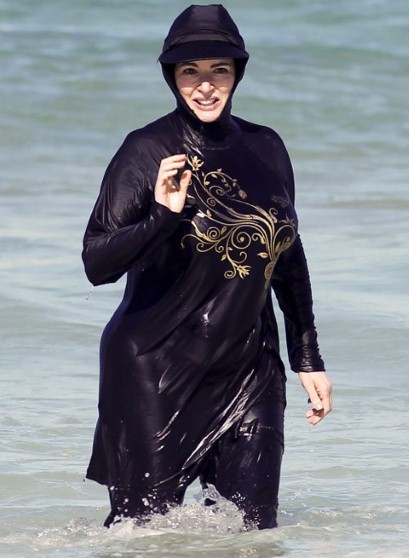Nigella Lawson and the “Burkini” Debate
She is the British food writer and self proclaimed ‘domestic goddess,’ known equally for her Rubenesque figure as she is for her mouth watering recipes. So when Nigella Lawson was photographed on Bondi Beach dressed in what has been described as a “burkini,” it was guaranteed to spark a debate. Why did she cover up? And more to the point- why do we care?
Suggested theories behind her choice of clothing range from it being a political statement, to extreme protection from the sun in an attempt to retain her alabaster complexion; either way Lawson was expressing her right to dress in a manner that she deemed suitable for the occasion.
Who would blame her if she was covering up to avoid the criticism faced by famous women whilst on the beach? As a woman of a certain age, and of a size which does not conform to conventional ideals, Lawson would no doubt come under the scrutiny of the usual host of women’s weekly magazines. The familiar ‘circle of shame,’ used to highlight even the smallest of ‘imperfections,’ reinforces negative body image instead of embracing diversity and empowering women.

As a fuller figured woman who seems comfortable in her own skin, Nigella Lawson represents an army of women who realise that there is more to life than what the weekly rags deem the perfect ‘bikini body.’
***
Post by Emma Case
Emma is a Fashion Marketing and Communications graduate who currently works as Sample Co-ordinator at a fashion trimmings company, she also works freelance as a fashion writer at Yogoego.com. Catch Emma on Twitter @EmmaOffDuty
***
Editor Charlotte Gush, on Twitter @CavaCharlotte
THE CHANGING FACE OF BLACK BEAUTY
The fashion industry plays a significant role in the way in which black women and most importantly, black beauty is defined. As an impressionable teenager I recall struggling to deal with the lack of black models in mainstream fashion magazines. It was frustrating to see yet another model styled to look androgynous or repeatedly featured in tribal/ethnic/sport inspired fashion stories. It would be fair to say that this had an impact on the way that I, as a black woman, viewed myself.Occasionally fashion magazines dare to be different and step away from the usual stereotypes; the April 2011 edition of ELLE UK is a good example.
The 12 page spread could easily have featured a caucasian model as there is no reference to the ethnicity of the model. What strikes me is that the images show a model, as apposed to a ‘black model’. On this occasion we are given the opportunity to view beautiful clothes, on an equally beautiful model - who just happens to be black.
It is all too easy to focus on the negative aspects of the fashion industry but it is important to acknowledge steps in the right direction. Hopefully ELLE UK will continue to promote diversity within their magazine.
***
Post by Emma Case
Emma is a fashion marketing graduate, who works as a Sample Coordinator for a trimmings supplier.
***
All images from Elleuk.com
Editor Charlotte Gush, on Twitter @CavaCharlotte